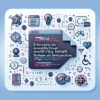Crafting Accessible Web Interfaces with HTML and CSS: Techniques and Tips

Introduction to Accessible Web Interfaces
In the contemporary digital era, designing web interfaces that are inclusive and accessible to all users, regardless of their hardware, software, language, location, or ability, is paramount. This commitment to digital accessibility not only ensures compliance with various legal standards but also expands the reach of your web content to a broader audience. This guide focuses on leveraging HTML and CSS, foundational technologies of the web, to create web interfaces that are accessible to everyone.
Understanding Web Accessibility
Web accessibility means making websites and web applications usable for people with disabilities, including those with auditory, cognitive, neurological, physical, speech, and visual impairments. It’s crucial in the development process, ensuring that as many users as possible can access and use your site effectively.
Key Principles of Web Accessibility
The Web Content Accessibility Guidelines (WCAG) outline several key principles to achieve an accessible web interface:
– Perceivable: Information and user interface components must be presentable to users in ways they can perceive.
– Operable: User interface components and navigation must be operable.
– Understandable: Information and the operation of the user interface must be understandable.
– Robust: Content must be robust enough that it can be interpreted by a wide variety of user agents, including assistive technologies.
HTML Techniques for Accessibility
HTML (HyperText Markup Language) is the backbone of any website and plays a critical role in accessibility.
Semantic HTML
Using semantic HTML tags (;<header>>, ;<footer>>, ;<nav>>, etc.) helps convey the structure and presentation of the document, making it easier for assistive technologies to interpret the content.
Alt Text for Images
Adding alternative text to ;<img>> elements is crucial for users who rely on screen readers. The ;alt> attribute should accurately and succinctly describe the image’s content or function.
Form Labels
Associating a ;<label>> element with every input field improves accessibility, as it provides context for the field. For users who rely on screen readers, this makes forms easier to navigate and understand.
CSS Techniques for Accessibility
Cascading Style Sheets (CSS) control how web pages are displayed and can greatly enhance the accessibility of web content.
Flexible and Responsive Design
Ensure your site is usable on any device by employing responsive design techniques. Using relative units (like percentages and EMs), rather than fixed units (like pixels), makes your site more adaptable to different screen sizes and resolutions.
Color and Contrast
Colors play a significant role in the accessibility of a web interface. It’s essential to ensure sufficient contrast between text and its background to aid users with visual impairments. Avoid using color as the sole method of conveying information.
Keyboard Navigation
Many users rely on keyboards to navigate websites. Ensure all interactive elements are accessible using keyboard shortcuts. CSS can be used to highlight focused elements, improving visibility and orientation for users navigating without a mouse.
Conclusion
Creating accessible web interfaces is a fundamental aspect of modern web development that should never be overlooked. By applying the HTML and CSS techniques outlined above, you can ensure your website is more inclusive to all users. Embracing web accessibility not only broadens the reach of your web interface but also enhances the overall user experience, paving the way toward a more accessible internet for everyone.
—Remember, while this guide provides a solid foundation, web accessibility is a broad field that evolves continuously. Always stay updated with the latest guidelines and techniques to ensure your web content remains accessible to the widest possible audience.


